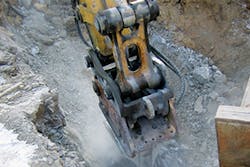When trenching and using shoring, Mitch Post, Mabey Inc.’s training and development manager says that soil type only matters to a point. “One common mistake contractors make is placing too much emphasis on that soil typing. If you look strictly at the OSHA definition of what types of soil and what characteristics they have, almost anytime you dig, you’re digging in type C soil,” offers Post. “If it’s been previously disturbed, if it’s been dug up before, if it consists of fill, if there’s groundwater present—it’s almost always a type C soil.”
OSHA defines the three soil types as follows:
- High Stablity—Type A: Clay, silty clay, and hardpan. No soil is Type A if it is fissured, is subject to vibration, has previously been disturbed, or has seeping water.
- Medium Stability—Type B: Silt, sandy loam, medium clay, and unstable dry rock. Previously disturbed soils, except those that would be classified as Type C. Soil that meets the requirement of Type A soil, but is fissured or subject to vibration.
- Low Stability—Type C: Gravel, sand, loamy sand, soft clay, submerged soil, dense unstable rock, or soil from which water is freely seeping.
If the type of soil wasn’t enough to worry about at a potential trench site, there are also other potential geological problems waiting for contractors. Shale limestone, sandstone, and other soft to medium hard rocks can slow down a project if a contractor doesn’t have the right tools to handle the job.
Aaron Lewis is the marketing director for Antraquip, a company that manufactures hydraulic attachments for excavators. Hydraulic cutters or “grinders” are commonly used when a contractor needs to cut a trench through a surface containing hard rock. Lewis says these tools save time and money on projects that require any rock cutting to dig a trench.
“Upon talking to a contractor, we actually help them understand the rock hardness, whether we get that through project job-site reports,” says Lewis. Experts at Antraquip can check an in-house database of rock hardness in various geographic areas around the globe. And Lewis says, “If for some reason we do not have any idea what the rock hardness would be in that area, then we would actually fly out there and test the rock. That’s our biggest thing. We want to make sure we properly position the tool for the right application.”
Contractors will generally choose their tool based on the needs of the job. The type of tool they choose largely depends on the width and depth of the trench.
The process of digging the trench can present problems, even if a contractor has planned carefully. Adverse variables can creep into the trenching process.
“They’re non-vibrational. A hammer can be percussive. You got two pieces of metal that slap together that cause an extremely loud percussion. That sends a vibration back throughout the machine, and basically you’re crushing the life out of your machine. Contractors are well aware that hammers are very aggressive on their machines,” notes Lewis. “The grinders are completely opposite. Because there are so many picks and they strike the ground at such a consistent rotation, what ends up happening is you’re not left with the percussion.”
Lewis says Antraquip’s hydraulic cutter cuts down on the noise and disturbance in the local trenching area. “Contractors are really able to see the major benefits of these in urban environments where they actually have sound restrictions. So let’s say they got a project that dictates ‘you guys cannot use the hydraulic hammer because it will fracture surrounding structure’s windows—it’ll put hairline fractures throughout foundations.’ In that case, the only other option, unless they’re going to use hand tools, would be to use the hydraulic grinder to go on and break it up.”
LeRoy Hagenbuch is the president and chief engineer of Philippi-Hagenbuch, the company that manufactures the Rolling Wedge. Like Lewis, he agrees that hydraulic hammers are not an efficient way of breaking up rocks.
His product takes rock breaking a step further and does not even use a pick. He says his Rolling Wedge trencher works in a different way. “The Rolling Wedge is meant for those applications that are challenging. There’s basically two ways to break material: you can either crush it, or you can cause it to be pulled apart. And if you want a large chunk of concrete and you want to break it, if you get a hole in it, it’ll pop.”
The Rolling Wedge is a device that can attach to an existing trencher. Hagenbuch says his product distinguishes itself from others on the market because it avoids violent actions with hard surfaces.
“You don’t have the percussive action of the cutting, of picking. Brute force is what they are using to try to cut through the material. We’re not trying to use brute force. Rolling Wedge has an edge grabbing material and literally pulls it apart,” he says. “Concrete in particular, as well as many other similar materials, has a very low tensile strength compared to its compression strength. So the secret of the Rolling Wedge is to get on something and pull it apart, as opposed to trying to crush it and break it up.”
While the Rolling Wedge can work on any surface, ideally, the machine is meant for harder surfaces. “What we’ve done on this is create something that is meant for the harder, more challenging trenching applications, such as profiling. Basically [something] like frozen ground can be difficult for a normal machine to trench through. We’re probably trenching at 80% or better of the rate as if the ground were unfrozen,” says Hagenbuch.
Still with some trenchers, it’s an either/or proposition. They either cut into dirt or hard surfaces—but they don’t work on both. Rolling Wedge, says Hagenbuch, provides versatility for contractors looking to save more on trenching projects, and anyone looking to trench in soil types A, B, and C. “It allows you to have a cutter you can use more universally than some other of the other cutters out there today,” he says. “It is a product that takes less power to operate than other methods of trenching. It is a product that pulls apart material and takes less energy to do it.”


